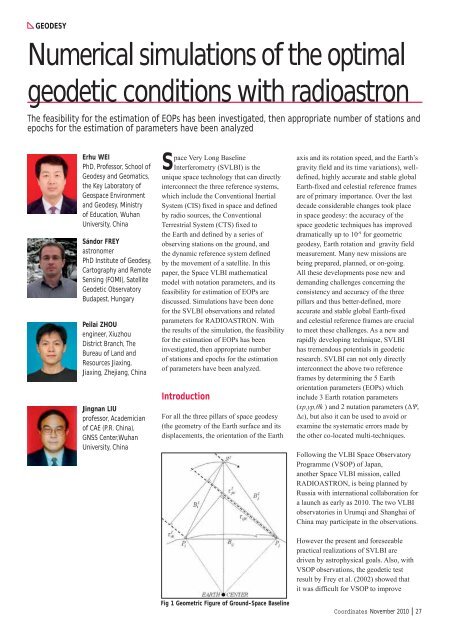Co-ordinates
Co-ordinates
Co-ordinates
Create successful ePaper yourself
Turn your PDF publications into a flip-book with our unique Google optimized e-Paper software.
GEODESY<br />
Numerical simulations of the optimal<br />
geodetic conditions with radioastron<br />
The feasibility for the estimation of EOPs has been investigated, then appropriate number of stations and<br />
epochs for the estimation of parameters have been analyzed<br />
Erhu WEI<br />
PhD, Professor, School of<br />
Geodesy and Geomatics,<br />
the Key Laboratory of<br />
Geospace Environment<br />
and Geodesy, Ministry<br />
of Education, Wuhan<br />
University, China<br />
Sándor FREY<br />
astronomer<br />
PhD Institute of Geodesy,<br />
Cartography and Remote<br />
Sensing (FOMI), Satellite<br />
Geodetic Observatory<br />
Budapest, Hungary<br />
Peilai ZHOU<br />
engineer, Xiuzhou<br />
District Branch, The<br />
Bureau of Land and<br />
Resources Jiaxing,<br />
Jiaxing, Zhejiang, China<br />
Jingnan LIU<br />
professor, Academician<br />
of CAE (P.R. China),<br />
GNSS Center,Wuhan<br />
University, China<br />
Space Very Long Baseline<br />
Interferometry (SVLBI) is the<br />
unique space technology that can directly<br />
interconnect the three reference systems,<br />
which include the <strong>Co</strong>nventional Inertial<br />
System (CIS) fixed in space and defined<br />
by radio sources, the <strong>Co</strong>nventional<br />
Terrestrial System (CTS) fixed to<br />
the Earth and defined by a series of<br />
observing stations on the ground, and<br />
the dynamic reference system defined<br />
by the movement of a satellite. In this<br />
paper, the Space VLBI mathematical<br />
model with notation parameters, and its<br />
feasibility for estimation of EOPs are<br />
discussed. Simulations have been done<br />
for the SVLBI observations and related<br />
parameters for RADIOASTRON. With<br />
the results of the simulation, the feasibility<br />
for the estimation of EOPs has been<br />
investigated, then appropriate number<br />
of stations and epochs for the estimation<br />
of parameters have been analyzed.<br />
Introduction<br />
For all the three pillars of space geodesy<br />
(the geometry of the Earth surface and its<br />
displacements, the orientation of the Earth<br />
Fig 1 Geometric Figure of Ground-Space Baseline<br />
axis and its rotation speed, and the Earth’s<br />
gravity field and its time variations), welldefined,<br />
highly accurate and stable global<br />
Earth-fixed and celestial reference frames<br />
are of primary importance. Over the last<br />
decade considerable changes took place<br />
in space geodesy: the accuracy of the<br />
space geodetic techniques has improved<br />
dramatically up to 10 -9 for geometric<br />
geodesy, Earth rotation and gravity field<br />
measurement. Many new missions are<br />
being prepared, planned, or on-going.<br />
All these developments pose new and<br />
demanding challenges concerning the<br />
consistency and accuracy of the three<br />
pillars and thus better-defined, more<br />
accurate and stable global Earth-fixed<br />
and celestial reference frames are crucial<br />
to meet these challenges. As a new and<br />
rapidly developing technique, SVLBI<br />
has tremendous potentials in geodetic<br />
research. SVLBI can not only directly<br />
interconnect the above two reference<br />
frames by determining the 5 Earth<br />
orientation parameters (EOPs) which<br />
include 3 Earth rotation parameters<br />
(xp,yp,θk ) and 2 nutation parameters (ΔΨ,<br />
Δε), but also it can be used to avoid or<br />
examine the systematic errors made by<br />
the other co-located multi-techniques.<br />
Following the VLBI Space Observatory<br />
Programme (VSOP) of Japan,<br />
another Space VLBI mission, called<br />
RADIOASTRON, is being planned by<br />
Russia with international collaboration for<br />
a launch as early as 2010. The two VLBI<br />
observatories in Urumqi and Shanghai of<br />
China may participate in the observations.<br />
However the present and foreseeable<br />
practical realizations of SVLBI are<br />
driven by astrophysical goals. Also, with<br />
VSOP observations, the geodetic test<br />
result by Frey et al. (2002) showed that<br />
it was difficult for VSOP to improve<br />
<strong>Co</strong><strong>ordinates</strong> November 2010 | 27
















